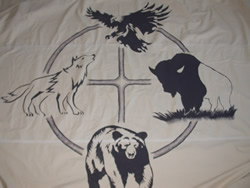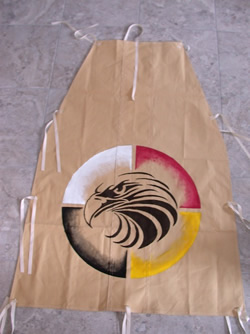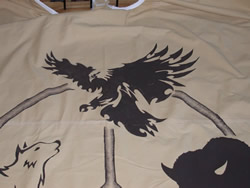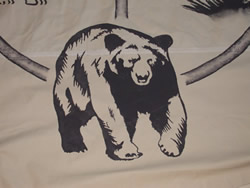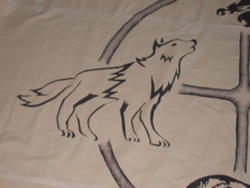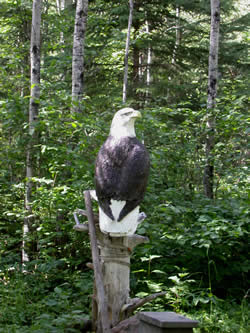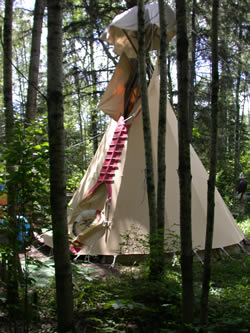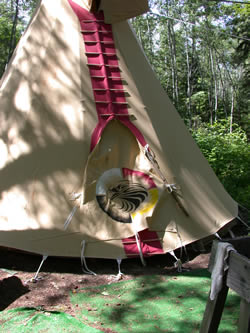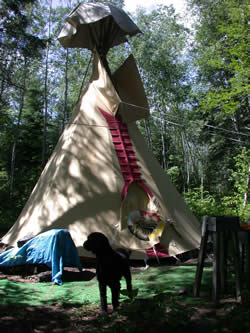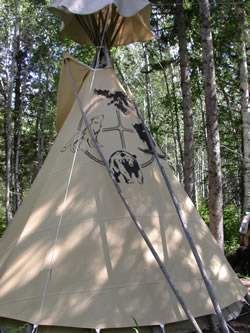During the summer season of 2012 the Tipi cover I have been using since 2004 was showing real signs of wear, weather, and bear attacks. The cuts from bear claws were becoming longer and harder to repair and likely were so because the canvas fibres were weakening. I decided it was time to replace the cover and made that investment over the winter of 2012 - 2013. I ordered a tan canvas cover from Nomadics Tipi Makers. I am also down-sizing from a 18 foot Tipi to a more manageable 16 foot Tipi. Before I will set it up once the warmer weather comes and the snow goes, I decided to paint my Spirit Helper images onto the canvas. I can not claim the inspiration for the graphic images used but I do appreciate the artistic talents of those who conceived and created the images. I merely used, arranged and painted them onto my Tipi.
I will add additional images of the camp when Spring comes and I raise the Tipi. (Posted below)
The smoke flaps are open, there is a warming fire going inside, but the door flap is closed to hold out the swarms of mosquitoes that inhabit the land this July 2013. The red band that begins at the base of the entrance side and runs up through the lacing pins, represents the journey on the Hoop, along the Red Road. So even when the Waluta is not present and flying in the breeze, that red band represents a commitment to a way of living.
This image shows the rain cap over the top of the poles. That rain cap, while looking rather awkward and unattractive, serves a wonderful purpose. When it rains water is shed and does not run down the poles. In the first few years I followed the advice of the Tipi Makers and used twigs to lift the liner ropes along the inside of the poles so that rainwater would have a channel to the ground and would not drip into the tipi. For the main that did work, but there was always some roughness or edge along the pole that would cause the water to pool and then drip onto the floor. Then we started having really rainy summers, and the unsightly rain cap made more and more sense. Now I would not want to leave it up for a longer period without the rain cap.
The same with an angle more to the left to show Wolf. This also shows the role of the smoke flap poles in adjusting the flaps so that smoke is drawn out of the tipi. I have a small cast iron stove with a 4 foot long pipe and rain cap inside which really helps control the burn, directs the smoke to the opening, and is much safer than an open fire or even a fire with a screen cover as I used before. The only disadvantage is that heating a billy of water for tea on the stove takes much longer than it took when hung over the open fire.
I have not spent nearly as much time out here as I would like. It is a wonderful place to go to think, to pray, to sleep, to listen to the wind or from which to listen to night animals. I will not prepare food here to avoid lingering food odours that would attract bear to investigate and enter. So far the resident bear for this season has not made an entrance or disturbed it in any way that I have been able to detect. I might have my neighbours to the East to thank for that. They are still feeding birds with birdseed on their deck, and bear has found that to be a more likely place to look for food. Besides, bear is a smart animal, and when bear smells my presence he has correctly decided that stringy old meat is not a very desirable meal.
